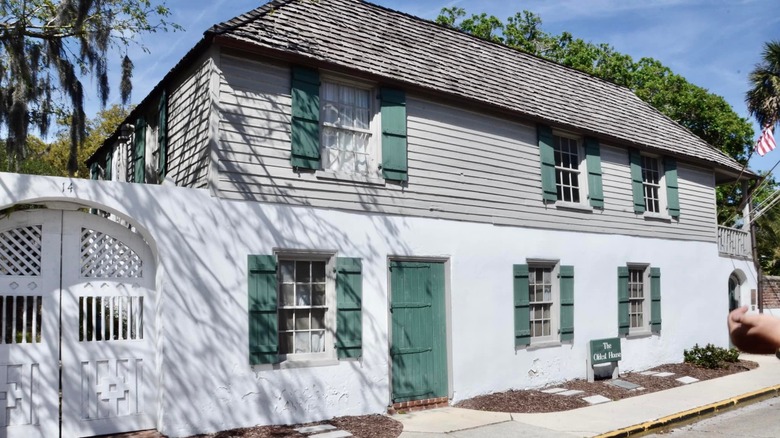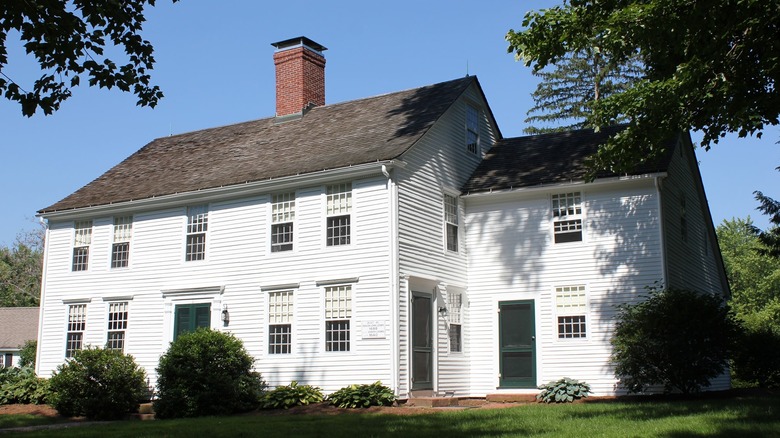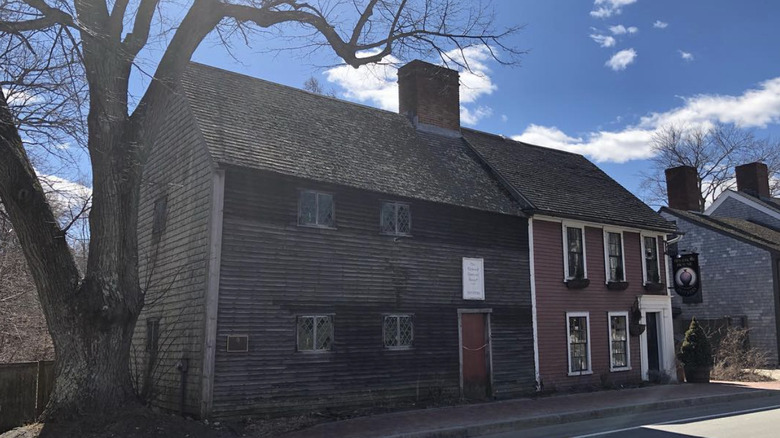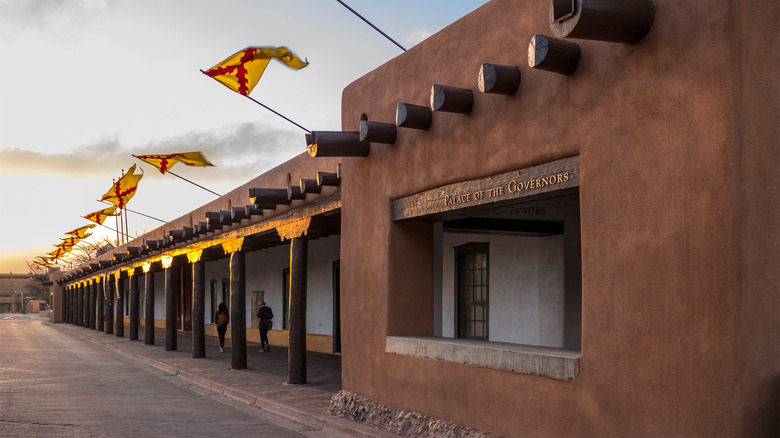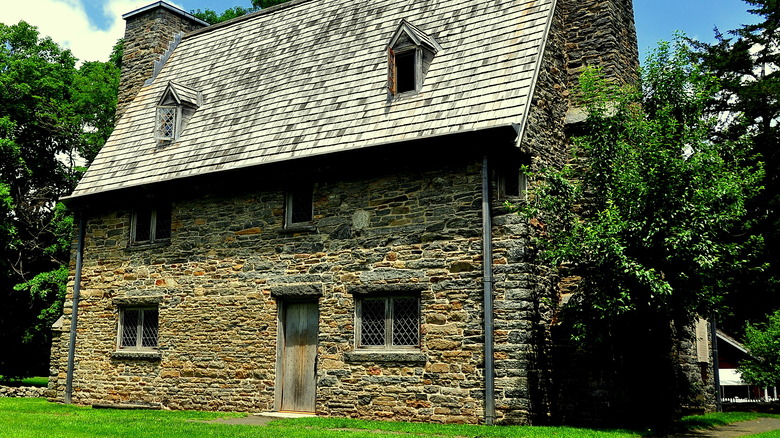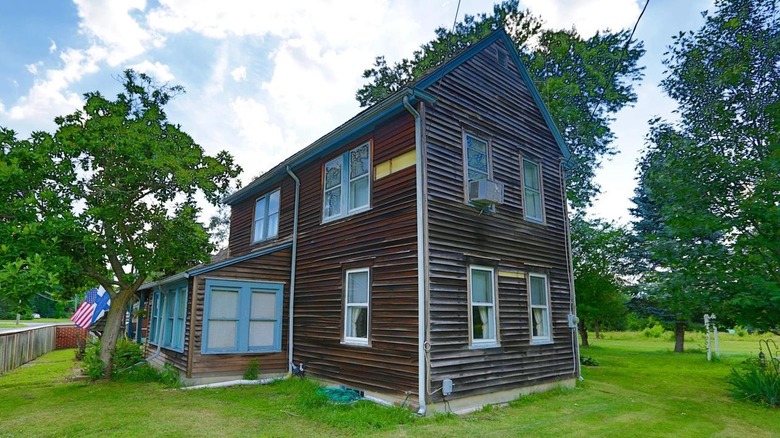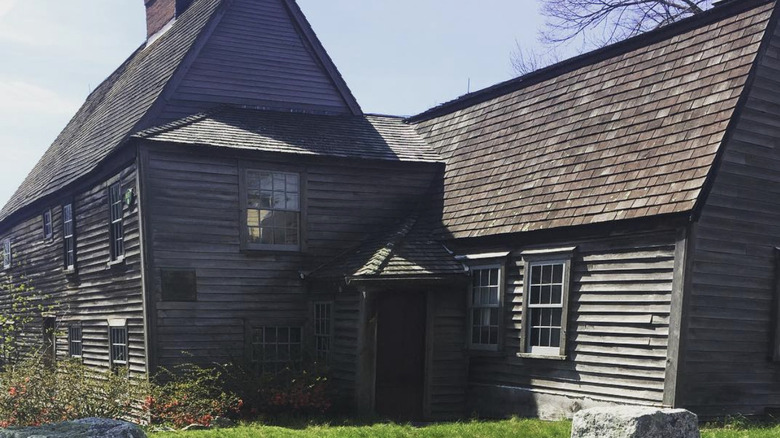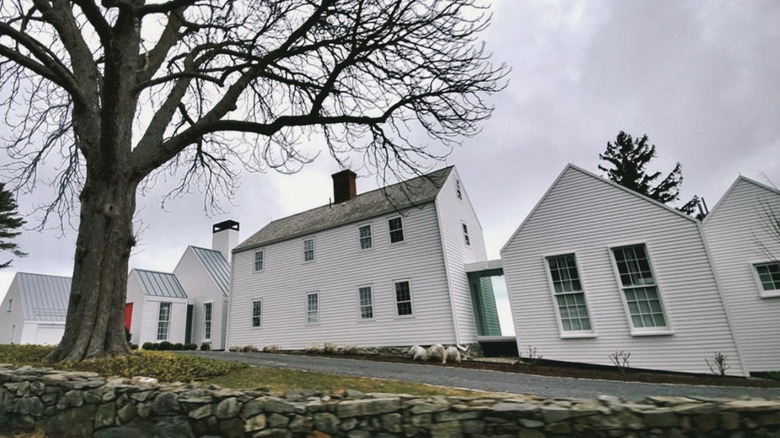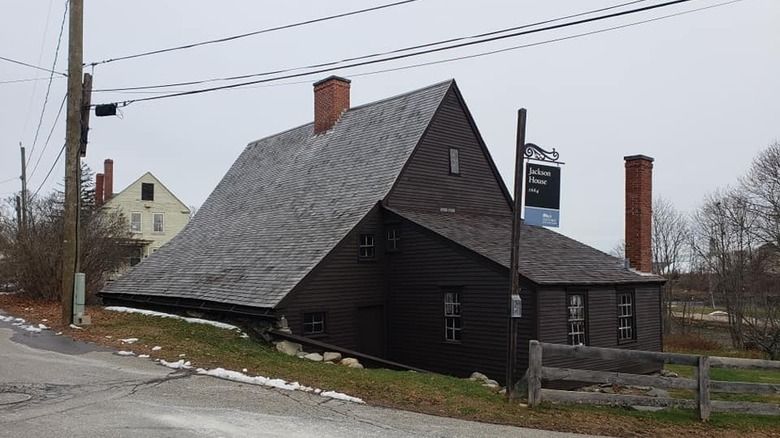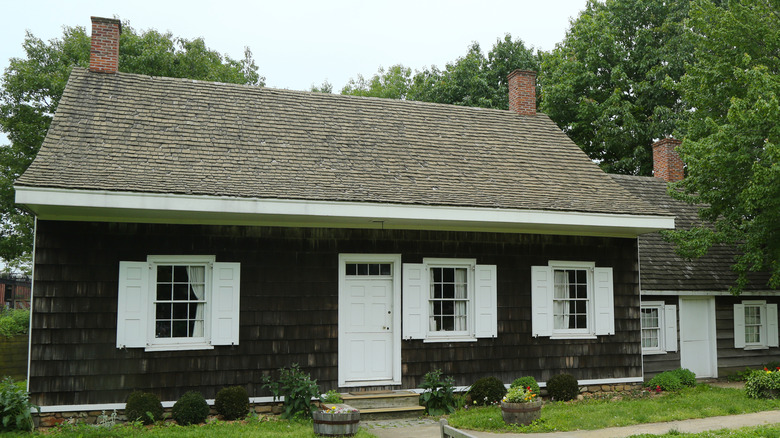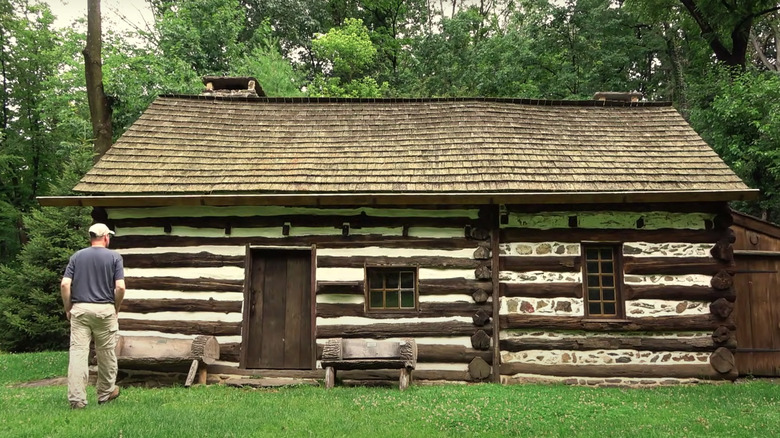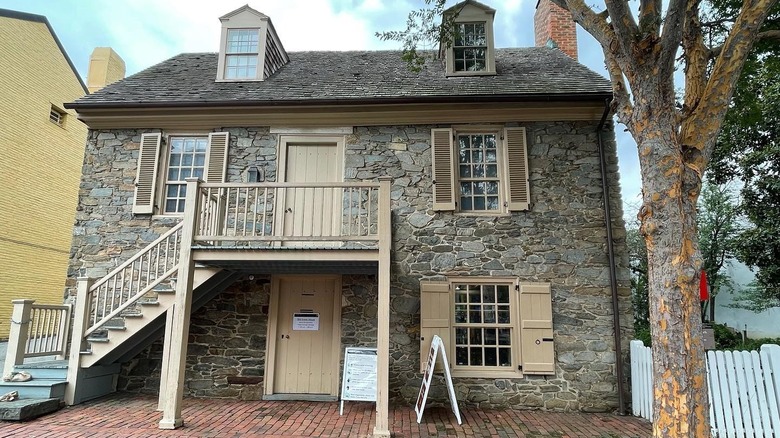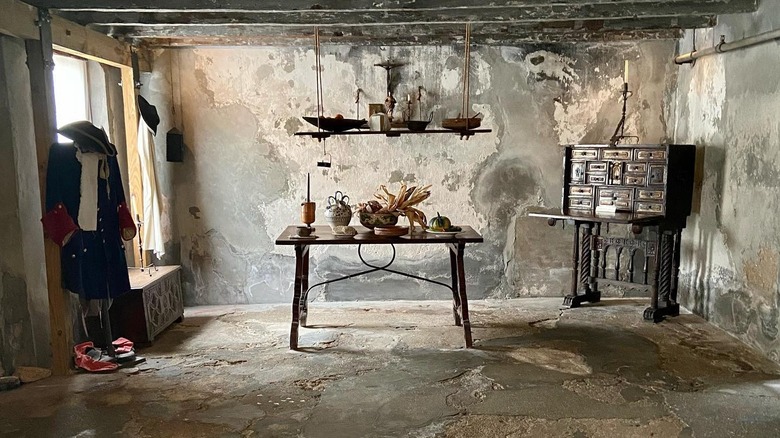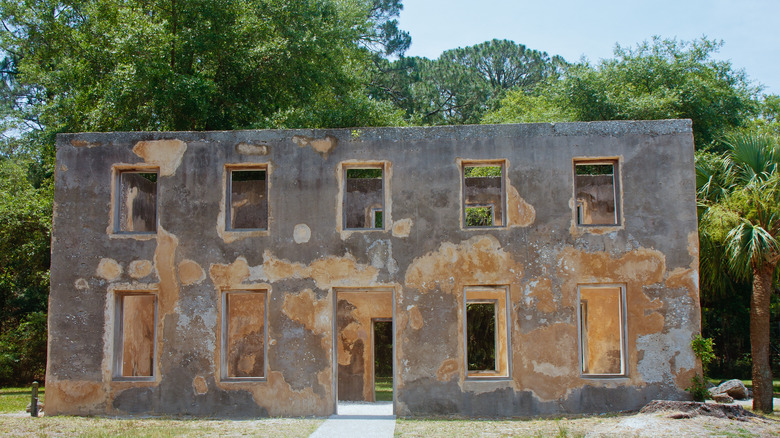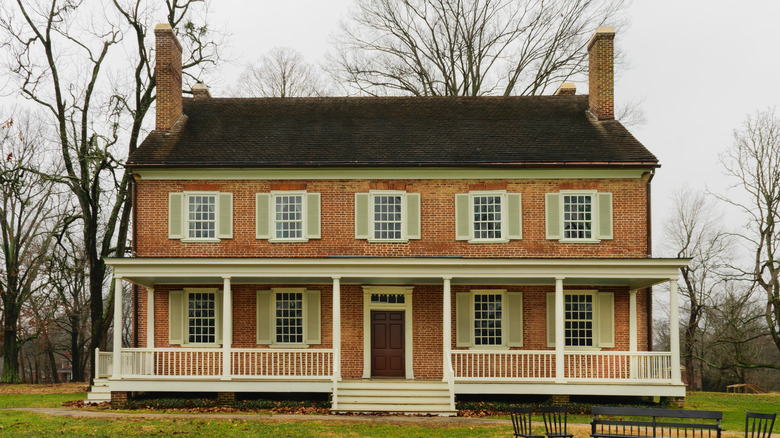Inside The Oldest Homes In America
For most people, their dream home includes floor-to-ceiling windows, clean edges, modern amenities, and top-of-the-line appliances. But not all home buyers feel this way. For others, an old house with endless charm and history is the only abode that does the trick. According to Millionacres, there are many benefits to buying an older home, including a lower price and lower property taxes. Plus, the property itself tends to be larger, and the structure is more likely to survive the test of time since properties from past eras tend to be built more solidly with higher-quality materials.
Don't believe us? Just look at the oldest homes in America. These houses have been around for 300 to 400 years, watching history pass by for centuries. Some of these historic homes are open for tourists and educational visits, while others are private residences that people still live in today. Perhaps the best perk of owning an older, character-filled home is that living inside is a timeless adventure.
The Loomis Homestead in Connecticut was built by one of the first settlers
As one of the original 13 colonies, it's not surprising that Connecticut is home to one of the oldest houses in America. The Loomis Homestead is located in the town of Windsor, minutes away from the state's capital of Hartford. According to Lost New England, the homestead dates back to 1640 and was one of the first homes ever built in town by, fittingly, one of the first residents. Joseph Loomis left England in search of a better life just two years before building his American abode. He brought along his wife Mary, as well as their eight kids, to the New World, where they were given nearly two dozen acres of land.
Loomis didn't choose his new home's location by accident. He built his new house on a part of the property that was slightly higher than the rest, ensuring that rain wouldn't flood his new house, but rather the greenery around it. After the home was passed on to Loomis's family following his death in 1688, it underwent several additions. The additions and renovations continued until 1950 and included making the wood walls look brand new and removing the dilapidated porch. Otherwise, much of the Loomis Homestead remains just as it did when Loomis originally built it.
The Richard Sparrow House in Massachusetts housed a family of five in two rooms
When Richard Sparrow and his wife Pandora and their young son left England in 1633, they were given six acres of land in New Plimoth, Massachusetts. However, there was a catch. They had to build a home on the property within just a few years. Sparrow House reports that Sparrow created a two-floor home starting in 1636 right next to a brook, making it easy for the family to fetch water. However, that was one of the structure's only perks. Even by 17th century standards, the place was tiny. It felt even smaller after the Sparrows had two more kids. Even though the house stayed the same size, the Sparrow property grew. As the family patriarch received more political duties, the family received additional tracts of land.
Finally, in 1653, it didn't make sense for the growing family to live there anymore, and they headed to Plymouth. Today, people can still visit the Richard Sparrow House, which maintains its wood-paneled exterior and red door at 42 Summer Street. It still has the original windows, made of leaded glass, and the exposed cross beams that have kept the space intact for hundreds of years.
The Palace of the Governors in New Mexico is the oldest structure in the country still in use today
The Palace of the Governors in Sante Fe, New Mexico takes the cake when it comes to longevity — it's the oldest structure in America built by European settlers that's still in use today. However, you wouldn't necessarily know that by looking at it. According to the New Mexico History Museum, The Palace of the Governors dates back to 1610. Over the past 400 years, the structure has undergone many renovations to reflect different architectural trends. While first used as an administrative building, it's now the base of the Museum of New Mexico.
Today, it's designed in a Spanish-Pueblo Revival style since that's what many other historic buildings in town reflect. It's also small but mighty. The Palace of the Governors is only one floor, but it's a National Historic Landmark and a National Treasure, named by the National Trust for Historic Preservation. Inside, visitors can buy artisan jewelry and visit rotating art galleries before moving on to other buildings that are also part of the museum. Visitors can also take tours of building, which, not surprisingly, is the most significant artifact at the Museum of New Mexico (via National Park Service).
The Henry Whitfield House in Connecticut was built on stolen land
With its beautiful stone façade, lush green lawn, and history dating back to 1639, the Henry Whitfield House is anything but an eyesore. However, its past isn't all pretty. According to Connecticut's Official State Website, the house was built after a group of English Puritans (including Reverend Henry Whitfield) colonized the area, now known as Guilford, after taking it from the Menunkatuck band of the Quinnipiac tribe. On the site, the English Puritans also built three other stone homes, which they lived in and also used as a defense against the tribe. While the Henry Whitfield House received extensive renovations over the years, it still has its original ambiance. Therefore it was named a National Historic Landmark.
Over 100 years ago, the state bought the home and began to open it for tours. Today, visitors can check out the Henry Whitfield House's three floors on their own, a history exhibit, and the period furnishings. There's also an onsite gift shop, library, changing exhibits, a barn that dates back to 1870, manicured grounds, and a scavenger hunt for kids. The grounds feature a statue of Whitfield, a historic cannon, and a peaceful trail ideal for relaxing hikes.
The C.A. Nothnagle Log Home in New Jersey is the oldest log cabin in the United States
If you have $2.9 million, you're probably not itching to live in a 16-by-22 square foot, one-room cabin from 1639. At least that's what the Rink family found when they put the C.A. Nothnagle Log Home in Gibbstown, New Jersey on the market. As reported by 6sqft, owners Doris and Harry Rink put the cabin up for sale, under the condition that they can keep giving tours of it forever. So far, it doesn't appear to have any takers, although it might be a steal for someone who appreciates a bit of history. It was up for sale for 2.9 million in 2017, but has since gone down in price to $750,000. The C.A. Nothnagle Log Home is the oldest log cabin in America, and it's on the National Register of Historic Sites.
Plus, it's back to its original splendor (even though that doesn't amount to much compared with today's standards). The Rinks restored the cabin on their own, exposing the original logs behind a bizarre plaster covering. They also de-weeded the property and strengthened the cabin's floors and roof to make it last for another 400 years. And it seems like this house may pass the test of time. Instead of nails welding the wood together, double-dovetail joinery does the job here two-fold. A few logs come out of the wall to create a gentle breeze on summer days.
The Fairbanks House in Massachusetts is the oldest timber-framed house on the continent
Most 17th-century houses are the work of settlers who were not construction experts, and many of the structures did not last through the years. The Fairbanks House in Dedham, Massachusetts is still standing today because the Fairbanks family hired a carpenter and mason to build their home. The Fairbanks House is known as the oldest timber-framed house on the continent. Per the Fairbanks House Historical Site, the family moved to America from England just four years before constructing the home in 1637.
For nearly 200 years, the Fairbanks House passed between generations. To no surprise, the house did change in those two centuries. The entire space eventually doubled, with two entirely new portions of the home. When paint, wallpaper, and large windows were extravagancies reserved for the wealthy, the Fairbanks House enjoyed it. However, around 1820, it all seemed to come to an end. Amenities like heat, freshwater, and electricity never made their way to the Fairbanks House, as the Fairbanks family ran out of cash. At least visitors can see the home in its original glory since it's open to the public from May through October.
The John Bray House in Maine has been reimagined as a modern seaside abode
Nowadays, most historic homes are museums and tour sites rather than actual homes. But that's not the situation for the John Bray House in Kittery Point, Maine, which is the oldest home in the state and dates back to 1622. According to Decor Maine, after Jonathan King and Jim Stott decided to buy the historic property in 2015, they found an architect who could make the John Bray House a modern abode that pays homage to its unique history. The result was a modern farmhouse equipped with wood floors and a traditional color palette.
In the living room, beige couches sit around a black wood-burning fireplace. A mounted moose head and landscape paintings by local artists hang on the walls. In the primary suite, floor-to-ceiling windows frame amazing views of the sea. They are located next to yet another cozy fireplace for staying warm on chilly Maine nights. Outside, former fishing sheds and open property contain a variety of amenities for King and Stott, like an area for visitors, a library, pool, and pool house. However, it's all kept behind a classic white façade that provides a glimpse of the home's long history.
The Jackson House in New Hampshire is the oldest wood-framed home in the state
There's a reason the Jackson House of New Hampshire, which is the oldest home framed with wood in the state, features a strange combination of colonial and Medieval architecture. According to Historic New England, the home was constructed by woodworker Richard Jackson in a unique style. It combines a post-Medieval style with the wood often used by Americans in home construction. He built the house on his 50-acre property in 1664 with vertical wood planks.
The Jackson House proved its worth to the Jackson family over the years. It stayed in the family until 1924, and many Jackson family members lived here, including over 12 people in 1727. But in 1924, the founder of Historic New England bought it from one of the Jacksons. The founder of the organization, William Sumner Appleton, got to work immediately. He restored sections so that the property could become an educational tool for the public. That dream came to fruition, and today, people can visit the home on the second and fourth Saturday of every month from June through October. The home has also been named a National Historic Landmark.
The Wyckoff House in New York City is the Big Apple's first landmark
It's hard to imagine a home from 1652 in bustling New York City, but that's the case for the Wyckoff House Museum in East Flatbush-Flatlands, Brooklyn. Per the Historic House Trust of New York City, the Wyckoff House is the oldest building in the entire state and was also the first to be named a city landmark, which happened in 1965. The farmhouse, typical of Dutch-American farms of the time period, was built by Pieter Claesen Wyckoff after he and his wife moved to the area with their dozen children from the Netherlands. The family farmed the surrounding land on the 1.5-acre property. The original, 13-member Wyckoff family now has a whopping 50,000 ancestors.
Later generations continued to live in the Wyckoff House until 1901. The house was later donated to the city to be enjoyed by the public. While the house saw some alterations through the years, t's still a popular educational spot since it maintains its original charm with stone floors, a large fireplace, hardwood floors, and ceilings.
The Lower Swedish Cabin in Pennsylvania was used as a movie set
While most historic log cabins only functioned as family homes in the past, the Lower Swedish Cabin in Upper Darby, Pennsylvania saw many different uses throughout its nearly 400-year history. It's been a trading post and a movie set, to name a few. As reported by Atlas Obscura, Swedish settlers constructed the two-story cabin as a place to trade tools, furs, crafts, and more with Indigenous people.
Much later, in the 1900s, it was a popular spot for filming movies, especially for German motion picture pioneer Siegmund Lubin who made movies like "Uncle Tom's Cabin" and "The Bold Bank Robbery." However, it eventually fell into disrepair and became the target of graffiti and other vandalism. Finally, though, things turned around for the Lower Swedish Cabin about 40 years ago. The cabin joined the National Register of Historic Places in 1980, and experts got to work restoring it to its former glory.
The Old Stone House in Washington, D.C. is the oldest house in the district
As the birthplace of the modern-day United States, you probably might have guessed that one of the oldest homes in the country is in Washington, D.C. Per the National Park Service, the Old Stone House in Georgetown is the oldest house in its original spot in the district. But it has another claim to fame. According to legend, George Washington stayed here in 1791 when it was an inn and tavern, and later, he often met with locals to discuss various dealings here.
It all started in 1764 when former Pennsylvania residents Christopher and Rachael Layman bought the ground that the Old Stone House is on and got to work building their one-room house. It was modest in many other ways, too. It had dirt floors, low ceilings to keep heat inside, and ultra-thick stone walls to keep the rain and snow out. The owners planted produce and herbs on the property, and several animals lived onsite for dairy products and eggs. They also produced tobacco here. The Old Stone House remained a private home through the mid-1900s. In 1953, the government purchased the home for $90,000 to preserve it for the future.
González-Alvarez House is the oldest Spanish colonial home in Florida
A lot has happened in St. Augustine, Florida the last 450 years. It is the oldest region where European settlers lived in America, and Spanish, British, and American groups have all called it their own. According to the National Park Service, through it all, there's been the González-Alvarez House which was built in 1723 by Tomás González y Hernández. He was stationed at nearby Castillo de San Marcos and worked in the military. He constructed his rectangular abode to be just one story tall and equipped it with thick walls to keep the heat and harsh weather away. He topped the roof with wood and made the floors of materials from the beach like shells, sand, and lime. A gentle breeze came through the open windows.
For four decades, he and his family called the two-story structure home. When Great Britain took over Florida in 1763, he headed to Cuba. For more than 10 years, the house sat abandoned. Eventually, the St. Augustine Historical Society bought the oldest Spanish colonial home in Florida. It's now open for visitors as a part of the St. Augustine Historical Society's Oldest House Museum Complex. There's also a rotating gallery, two museums, a lush garden, and a gift shop on-site.
The Horton House in Georgia is located on an island
Don't let the creepy, beaten-down façade of the Horton House or the eyebrow-raising name of its location (Jekyll Island) fool you. The Horton House, which dates back to 1743, is simply a historic home. Per Jekyll Island Authority, the house is the oldest one in Georgia. The home features tabby construction, a mix of shells, sand, and water. It was built and inhabited by Major William Horton, who owned 500 acres of land on the island. He also farmed hops and rye and built the first Southern brewery, so we're sure he was one of the most popular landowners on the island.
After Horton passed away, Christophe Poulain DuBignon moved into the Horton House in 1794. He moved to the island from France since things weren't going so well in his home country during the revolution. Things seemed to go much better for him on Jekyll Island. He eventually owned the entire island, and many generations of his family lived in the Horton House. DuBignon and some of his family members' gravesites are on the grounds. You can visit their graves and the house since the Horton House is open for self-guided tours.
Locust Grove in Kentucky was visited by many American presidents
Locust Grove in Kentucky might only see history buffs as visitors these days, but back in its heyday, the National Historic Landmark was quite the gathering spot. According to Kentucky Historical Society, William Croghan and his wife, Lucy Clark Croghan, lived here. Lucy was the sister of George Rogers Clark, who led the Lewis and Clark expedition along with Meriwether Lewis. Lewis and Clark explored the Louisiana Purchase and the Pacific Northwest in the early 1800s. However, that was by no means this home's only claim to fame.
Through the 1800s and early 1900s, many important political figures hung out here, including Vice President Aaron Burr, President James Monroe, and President Andrew Jackson. Even Kentucky artist John James Audubon did some of his best work here. Lewis and Clark also stopped here on their way back from their celebrated journey. Plus, George Rogers Clark, one of the most significant political developers of early Kentucky, once lived at Locust Grove.
